
 Service Hotline
Service Hotline
PCB Material:
1. Copper clad laminate: copper clad laminate, CCL for short, or base material
2. Copper foil: copper foil
3. Semi cured sheet: prepreg, abbreviated as PP
4. Ink:
5. Dry film:
6. Mesh:
7. Drill bit:
2、 General knowledge of PCB product characteristics and process:
1. Impedance: impedance
2. Warpage:
3. RoHS:
4. Backlight:
5. Anode phosphor copper ball:
6. Estimation method of surface area of electroplated copper anode:
7. ICD issues
3、 PCB process knowledge:
1. Etching factor: etch factor
2. Side erosion:
3. Pool effect:
4. A-stage resin
5. B-stage resin
6. Grade C resin: C-stage resin
7. Font color of base material:
8. MSDS:
9. SGS:
10.UL:
11.IPC:
12.ISO:
13.MIL:
14.JPC:
15.COV:
16.FR4:
17. PH value
18. Hull cell test
19. Current density a / DM2
20. TP: penetration power
21. Displacement reaction:
22. EDS: energy dispersive X-ray spectroscopy
23. SEM: scanning electron microscope
24. Binding
25. Javanni effect:
26. Vacuum degree:; degree of vacuum
1、 PCB Material:
Copper clad laminate: copper clad laminate, CCL for short, or plate
● TG: glass transition temperature, refers to the temperature at which glassy substances are mutually transformed between glassy state and high elastic state (commonly referred to as softening). In PCB industry, this glassy substance generally refers to the dielectric layer composed of resin or resin and glass fiber cloth. The Tg of our common TG plate is required to be greater than 135 ℃, the Tg of medium TG is required to be greater than 150 ℃, and the Tg of high Tg is required to be greater than 170 ℃. The higher the TG value, the better the heat resistance and dimensional stability.
● CTI: comparative tracking lndex, relative leakage index (or relative leakage index, leakage tracking index). The maximum voltage value that the material surface can withstand 50 drops of electrolyte (0.1% ammonium chloride aqueous solution) without forming leakage trace, unit: v.
● CTE: coefficient of thermal expansion. Generally, the linear expansion coefficient is used to measure the performance of PCB board. It is defined as the ratio of the increase of length to the original length under the change of unit temperature, such as z-cte. The lower the CTE value, the better the dimensional stability, and vice versa.
● TD: thermal decomposition temperature refers to the temperature at which the substrate resin loses 5% of its weight when heated. It is a sign of delamination and performance degradation caused by heating of the substrate of the printed board.
● Caf: resistance to ion migration. Ion migration of printed board refers to the electrochemical insulation damage phenomenon on the insulating substrate. It refers to the state that dendritic metal is precipitated between wires under the action of electric field after voltage is applied to circuits close to and parallel to each other on the printed board, or metal ion migration (CAF) occurs along the glass fiber surface of the substrate, Thus, the insulation between conductors is reduced,
● T288: it is a technical index reflecting the welding resistance conditions of printed board substrate. It refers to the longest time for the substrate of printed board to withstand the welding high temperature at 288 ℃ without bubble, delamination and other decomposition phenomena. The more this time is, the more favorable it is for welding.
● DK: dielectric constant, often called dielectric constant.
● DF: distribution factor refers to the ratio of the energy leaked in the insulating plate in the signal line to the energy remaining in the line.
● Oz: Oz is the abbreviation of the symbol ounce. It is called "ounce" in Chinese. It is an English unit of measurement. When it is used as a unit of weight, it is also called English Liang; 1oz means the thickness of copper with a weight of 1oz evenly spread over an area of 1 square foot (ft2). It is the average thickness of copper foil expressed by the weight per unit area. It is expressed by the formula, that is, 1oz = 28.35g/ft2.
Copper foil: copper foil
● Ed copper foil: electrolytic copper foil, common copper foil for PCB, cheap,
● RA copper foil: calendered copper foil, common copper foil for FPC,
● Drum side: smooth surface, smooth surface of electrolytic copper foil
● Matt side: rough surface, rough surface of electrolytic copper foil
● Copper: element symbol Cu, atomic weight 63.5, density 8.89 g / cm3, electrochemical equivalent of Cu2 1.186 g / ah.
Prepreg, abbreviated as PP
● Epoxy resin: an organic polymer compound containing two or more epoxy groups in the resin molecule. It is the resin component used in the semi cured sheet commonly used at present
● Dicy: dicyandiamide, a common curing agent
● R. C: resin content
● R. F: resin flow
● G.T: gel time gel time
● 5. C: volatile content
● Curing: epoxy resin and curing agent undergo cross-linking polymerization under certain conditions (high temperature, high pressure or light) to form a polymer with three-dimensional network structure.
Ink:
● Viscosity: viscosity refers to that when a fluid flows, there is relative motion between adjacent fluid layers, and friction resistance will be generated between the two fluid layers; Unit: Pascal second (Pa.s).
● Hardness: the hardness of the ink after pre baking is 2B, the hardness of the ink after exposure is 2h, and the hardness of the ink after post baking is 6h. Pencil hardness.
● Thixotropic: a property in which the viscosity of an ink changes when it is touched while it is still colloidal, also known as shake and sagging resistance; It is a kind of physical property of liquid, that is, its viscosity decreases in the stirring state and quickly recovers its original viscosity after standing. By stirring, the thixotropic effect lasts for a long time, enough to reconstruct its internal structure. In order to achieve high-quality screen printing effect, the thixotropy of ink is very important. Especially in the scraper process, the ink is stirred to make it liquid. This function speeds up the speed of ink passing through the mesh and promotes the ink separated by the original mesh line to be evenly connected into one. Once the scraper stops moving and the ink returns to a static state, its viscosity will quickly return to the original required data.
Dry film:
● Dry film structure:
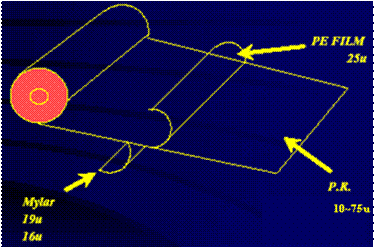
● The dry film consists of three parts and components:
o Support film (polyester film, polyester)
O photo resist dry film
O covering film (polyethylene film, polyethylene)
● Main components: ① binder (film-forming resin), ② photopolymerization monomer, ③ photoinitiator, ④ plasticizer, ⑤ tackifier adhesion Promoter, ⑥ thermal polymerization inhibitor, ⑦ pigment dye, ⑧ solvent
● Dry film types are divided into three categories according to different dry film development and film removal methods: solvent dry film, water-soluble dry film and stripping dry film; According to the use of dry film, it can be divided into anti-corrosion dry film, mask dry film and solder resist dry film.
● Photosensitive speed: refers to the amount of light energy required for the polymerization of photoresist monomer to form a polymer with certain corrosion resistance under UV irradiation. When the light source intensity and lamp distance are fixed, the photosensitive speed is expressed as the length of exposure time. Short exposure time means fast photosensitive speed.
● Resolution: refers to the number of lines (or spacing) that can be formed by dry film resist within 1mm. The resolution can also be expressed by the absolute size of lines (or spacing).
Mesh:
● Network density:
o T number \ mesh number: refers to the number of mesh within 1 cm in length.
bit:
● Bit geometry Name:
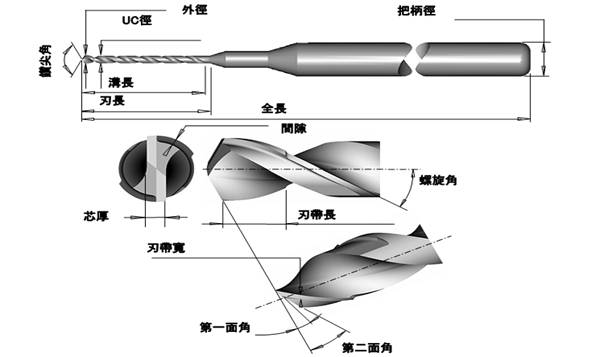
● Drill point angle
The drill point is composed of two narrow and long first drill point surfaces and two triangular hook shaped second drill point surfaces. The four sides meet at the drill point and form two short edges at the central meeting, which is called the transverse edge. It is the place where the plate is first touched. The transverse edge is positioned first under pressure and rotation and drilled into the stack, The two outer sides of the first sharp surface are respectively provided with a protruding square strip called margin, which has been circling up with the drill body, which is the contact part between the drill needle and the hole wall. The right angle corner at the junction of the edge rib and the edge lip is very important to the quality of the hole wall. The drill tip part is between the first tip surface and the second tip surface, and there is a long edge. The protruding point formed by the two long edges meeting with the two transverse edges in the middle part is the sharp point. The included angle formed by the two long edges is called the drill point angle. When drilling the paper phenolic resin substrate, there is less resistance, The drill tip angle is about 90 ° ~ 110 °. drill For FR4 fiberglass board, the sharp angle shall be slightly blunt, 115 ° ~ 135 °. The most common was 130 °. The clamping surface angle between the first sharp surface and the horizontal surface of the long edge is about 15 °, which is called the primary face angle, while the second sharp surface angle is about 30 °. In addition, the included angle formed by the transverse edge and the edge lip is called the transverse edge angle.
● Bit type:
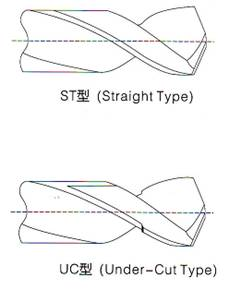
2、 PCB product characteristics and process communicationUsing knowledge:
Impedance: impedance
● The sum of resistance and reactance (capacitive reactance, inductive reactance) on the vector. The common impedance types are characteristic impedance and differential impedance.
Warpage:
● The maximum bow (figure a) and twist (Figure b) of printed boards using surface mount components shall be less than or equal to 0.75%

A bow B twist
RoHS:
RoHS is the abbreviation of the restriction of hazardous substances (the restriction of the use of hazardous substances in electrical and electronic equipment). RoHS lists six hazardous substances, including lead Pb, cadmium Cd, mercury Hg, hexavalent chromium Cr6, polybrominated diphenyl ether PBDE, Polybrominated biphenyl PBB.
Backlight:
It is an enlarged visual inspection method to check whether the through-hole copper wall is intact. Its method is to carefully grind the base material outside the hole wall from a certain direction, and then use the principle of resin translucency to shoot light from the back. If the chemical copper hole wall is in good quality without any holes or pinholes, the copper layer must be able to block light and appear dark in the microscope. Once there are holes in the copper wall, light spots must appear and be observed, and the photographic evidence can be enlarged. The ground sample is about 4-6mm wide.
Back light mark accurate chart



| element | Content (%) | element | Content (%) |
| Cu | ≥99.91 | Ni | ≤0.002 |
| P | 0.040-0.065 | Sb | ≤0.002 |
| Pb | ≤0.002 | As | ≤0.002 |
| Fe | ≤0.0025 | S | ≤0.002 |
| Sn | ≤0.002 | O | ≤0.002 |
● Features:
O a black (or brown black) film is formed on the surface of phosphor copper after power on
O black (or brownish black) film is cu3p, also known as phosphor copper anode film
● Function of phosphor copper anode film
O the anode film itself can catalyze and accelerate the (Cu -- e → Cu2) reaction, so as to reduce the accumulation of Cu.
O the formation of anodic film can inhibit the continuous production of Cu
O the conductivity of the anode film is 1.5x104-1 cm-1 with metal conductivity
O the anodization of phosphor copper is smaller than that of pure copper (1a / DM2) P0.04-0.065% phosphor copper anodization is lower than oxygen free copper (50mv-80mv), which will not lead to anode passivation.
O anodic film will greatly reduce the phenomenon of small grains falling off from the anode
O anodic film prevents the rapid dissolution of copper anode to a certain extent
Estimation method of anode surface area of electroplated copper:
● Estimation method of copper anode surface area of circular titanium basket: PDLF / 2
p=3.14 D = titanium basket diameter L = length of titanium basket F = coefficient
● Estimation method of square titanium basket copper anode surface area: 1.33lwf
L = length of titanium basket W = width of titanium basket F = coefficient
● F is related to the diameter of copper ball:
Diameter = 12mm F=2.2
Diameter = 15mm F=2.0 Diameter = 25mm F=1.7
Diameter = 28mm F=1.6 Diameter = 38mm F=1.2
ICD issues
Internal connection defects
3、 PCB process knowledge:
Etch factor: etch factor
● The index used to consider the etching side etching amount. Because the side etching amount will vary with different copper thickness, the etching factor is different from the total copper thickness.
● Calculation method:
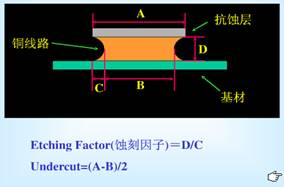
Lateral erosion:
● The etching of the side wall of the conductor under the resist pattern is called side etching, and the degree of side etching is expressed by the width of side etching:
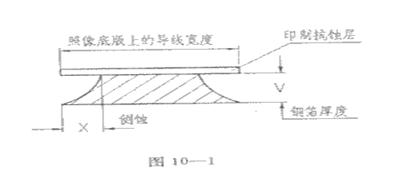
● Side etching is related to the type and composition of etching solution and the etching process and equipment used.
Pool effect:
In the etching process, the circuit board passes through the etching machine horizontally. Due to the action of gravity on it, the fresh potion is blocked by the old liquid and cannot effectively react with the copper surface.
A-stage resin
The thermosetting resin is liquid in the early stage of manufacturing or liquid after heating, and can still be dissolved in this liquid.
B-stage resin
A thermosetting resin can soften when heated in the middle stage of the reaction, but it can not be completely dissolved or melted. At this time, it can expand or partially dissolve in contact with some solvents.
C-stage resin
The later stage of the reaction of some thermosetting resins, at which time it is actually insoluble or immiscible.
Substrate font color:
Red font: flame retardant grade, other fonts: non flame retardant grade.
MSDS:
Material safety data sheet provides various information about safety, health and environmental protection for chemical substances and their products, as well as basic knowledge of chemicals, protective measures and emergency actions. In some countries, MSDS is also called material safety technical specification (SDS), and SDS terminology is used in ISO 11014.
SGS:
Societe Generale de surveillance S.A., translated as "general notary". Founded in 1887, it is the largest and oldest private third-party multinational company engaged in product quality control and technical appraisal in the world. Headquartered in Geneva, it has 251 branches, 256 professional laboratories and 27000 professional technicians around the world, and carries out product quality inspection, monitoring and assurance activities in 142 countries.
UL:
Under writers Laboratories Inc.
IPC:
The Institute for international and packaging electronic circuits (standard).
ISO:
International standards organization.
MIL:
Military standard.
JPC:
Japan printed circuit association.
COV:
Coefficient of variation is generally used for relevant indicators of electroplating uniformity and etching uniformity.
FR4:
Abbreviation for flame retardent type 4. It is the name of flame retardant printed circuit board material composed of glass fiber and epoxy resin. It is the most widely used printed circuit board.
PH value
● Also known as hydrogen ion concentration index and pH value, it is a scale of hydrogen ion activity in solution, that is, the measurement standard of solution pH in the general sense. This concept was put forward by Danish biochemist s ø Ren Peter lauritz s ø rensen in 1909. P stands for German potenz, which means strength or concentration, and H stands for hydrogen ion (H). Sometimes pH is also written as pondus hydrogenii in Latin.
● Under normal conditions (about 25 ℃ and 298K), when pH < 7, the solution is acidic, when pH > 7, the solution is alkaline, and when pH = 7, the solution is neutral.
Hull cell test
● Hull cell was designed by hull in 1939. Hull cell test only needs a small amount of plating solution. After a short time test, the plating effect of plating solution in a wide range of current density can be obtained; Because the test face is sensitive to the composition and operating conditions of the plating solution, it is often used to determine the concentration and pH value of each component of the plating solution, determine the current density range to obtain a good coating, and also commonly used for the fault analysis of the plating solution. Therefore, hull cell has become an indispensable tool for electroplating research and electroplating process control.
● Hull tank is usually made of insulating materials such as plexiglass or UPVC. The bottom is trapezoidal. The cathode and anode are placed on non parallel sides respectively. There are five capacities: 250ml, 267ml, 320ml, 534ml and 1000ml. Generally, 250ml plating solution is often added to 267ml test tank to convert the additives into grams per liter.
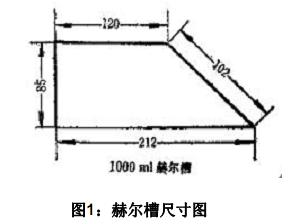
Current density a / DM2
A / DM2 -- how many amperes is the current intensity per square decimeter area, 1A / DM2? This is the current density of electroplating, which means that the current passing per square decimeter of workpiece electroplating area is 1A; DM means decimeter. Usually, we use 267ml hull tank, put the test piece at the cathode and immerse it in the test tank liquid. The area of the test piece is roughly 1dm2
TP: penetration power
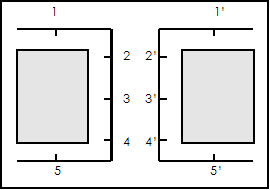

Displacement reaction:
Displacement reaction is a chemical reaction in which a simple substance reacts with a compound to form another simple substance and compound. Any displacement reaction belongs to double decomposition reaction, including the reaction between metal and metal salt, the reaction between metal and acid, etc; The replacement reaction must be redox reaction, and redox reaction is not necessarily replacement reaction; The substitution reaction takes place according to the sequence of metal activity.
EDS:energy dispersive x-ray spectroscopy X-ray energy dispersion spectrum
The surface of the sample to be tested is irradiated with a fine electron beam. Due to the interaction between the electron beam and the sample, various electronic or X-ray, photon and other information are generated. Then these information are collected and processed in different ways to show various characteristics of the sample (morphology, microstructure, composition, crystal surface, etc.)
SEM: scanning electron microscope
The electron beam with a diameter of 20 mm ~ 30 mm emitted from the cathode of the electron gun is subjected to the accelerating voltage between the cathode and the anode, and shoots into the lens barrel. After the convergence of the condenser and the objective lens, it is reduced to an electron probe with a diameter of about several nanometers. Under the action of the scanning coil on the upper part of the objective lens, the electron probe makes grating scanning on the sample surface and excites a variety of electronic signals. These electronic signals are detected by corresponding detectors, amplified and converted into voltage signals, and finally sent to the grid of the picture tube and modulate the brightness of the picture tube. The electron beam in the picture tube also makes grating scanning on the fluorescent screen, and this scanning motion is strictly synchronized with the scanning motion of the electron beam on the sample surface, so as to obtain a scanning electron image with contrast corresponding to the received signal strength, which reflects the morphological characteristics of the sample surface.
Binding: binding
Bonding is a wiring method in the chip production process. It is generally used to connect the internal circuit of the chip with the gold-plated copper foil of the packaging pin or circuit board with gold wire or aluminum wire before packaging. The ultrasonic wave from the ultrasonic generator (generally 40-140khz) generates high-frequency vibration through the transducer and is transmitted to the cleaver through the horn. When the cleaver contacts the lead and the weldment, Under the action of pressure and vibration, the metal surfaces to be welded rub against each other, the oxide film is damaged and plastic deformation occurs, resulting in the close contact between the two pure metal surfaces to achieve the combination of atomic distance, and finally form a firm mechanical connection. Generally, after bonding (i.e. after the circuit is connected with the pin), the chip is encapsulated with black glue.
Javanni effect:
It refers to that two metals produce current through the medium due to the potential difference, and then produce electrochemical reaction, and the anode with high potential is oxidized.
Vacuum degree; degree of vacuum
● The thinness of gas in vacuum state is usually expressed by "high vacuum degree" and "low vacuum degree". High vacuum degree means "good" vacuum degree, and low vacuum degree means "poor" vacuum degree. If the pressure in the measured equipment is lower than atmospheric pressure, a vacuum gauge is required for pressure measurement. The value read from the vacuum gauge is called vacuum degree. The vacuum value indicates that the actual value of the system pressure is lower than the atmospheric pressure, that is, vacuum = atmospheric pressure - absolute pressure;
● There are usually two methods for the identification of vacuum:
O first, it is marked with "absolute pressure" and "absolute vacuum degree" (i.e. how much pressure is higher than the "theoretical vacuum"); in practice, the absolute pressure value of the vacuum pump is between 0 and 101.325kpa. The absolute pressure value needs to be measured by the absolute pressure instrument. At 20 ℃ and altitude = 0, the initial value of the instrument (absolute vacuum gauge) used to measure the vacuum degree is 101.325kpa (i.e. one standard atmospheric pressure).
O second, it is marked by "relative pressure" and "relative vacuum" (i.e. how much pressure is lower than "atmospheric pressure"). "Relative vacuum degree" refers to the difference between the pressure of the measured object and the atmospheric pressure at the measuring place. Measure with an ordinary vacuum gauge. When there is no vacuum (i.e. under normal pressure), the initial value of the table is 0. When measuring vacuum, its value is between 0 and -101.325kpa (generally expressed as a negative number).
● Commonly used vacuum units include PA, kPa, MPa, atmospheric pressure, kg (kgf / cm2), mmHg, mbar, bar, psi, etc. The approximate conversion relationship is as follows:
o 1MPa=1000KPa
o 1KPa=1000Pa
O 1 atmospheric pressure = 100KPA = 0.1MPa
O 1 atmospheric pressure = 1kg (kgf / cm2) = 760mmhg
O 1 atm = 14.5psi
o 1KPa=10mbar
o 1bar=1000mbar